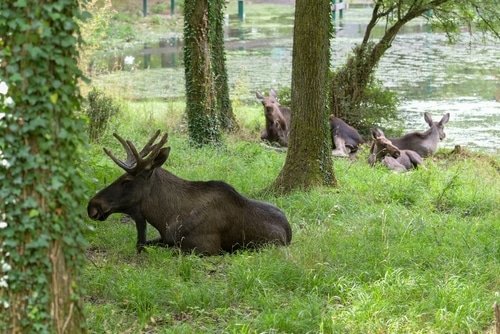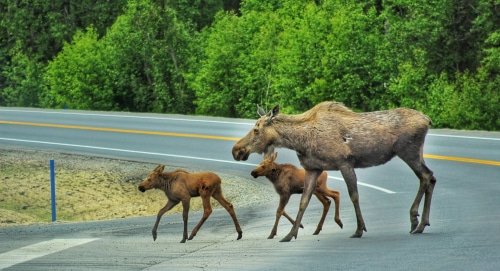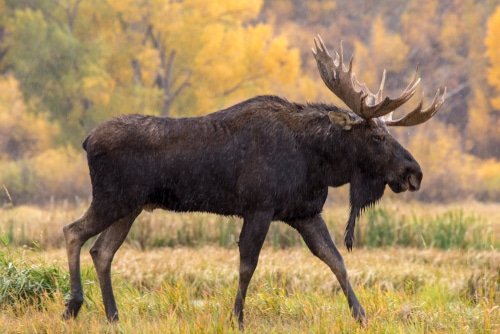Moose, the giants of the northern wilderness, have long captivated our imaginations with their imposing size and majestic antlers. However, with their population growth surging in recent years, addressing the ecological consequences of such an increase has become necessary. Understanding moose population control is crucial for preserving the delicate balance within these magnificent creatures’ ecosystems.
Moose population growth and its impact on ecosystems
Moose populations have experienced exponential growth in various regions, resulting in positive and negative ecosystem implications.
Herbivores play a vital role in shaping plant communities by selectively foraging on specific species, which can lead to changes in vegetation density and composition. Additionally, their browsing behavior can impact forest regeneration rates.
While these effects may be beneficial under certain conditions, an unchecked rise in moose numbers can tip the scales toward detriment. Excessive browsing can disrupt forest succession dynamics and decrease biodiversity by altering habitat availability for other wildlife.
Implementing effective population control measures
To maintain healthy ecosystems that support a diverse array of flora and fauna, it is imperative to implement effective population control measures for moose. Without intervention, unchecked growth may result in overbrowsing that negatively impacts forest ecosystem health.
Furthermore, imbalanced populations can exacerbate conflicts between humans and wildlife as moose encroach upon agricultural lands or pose risks on roadways. By carefully managing moose populations through ethical practices like hunting for conservation or exploring non-lethal methods such as contraception or wolf reintroduction programs as natural predation control mechanisms – we can strive towards achieving equilibrium between human needs and environmental sustainability.
In subsequent sections of this article, we will explore the various natural and human factors that influence moose populations and the innovative techniques employed to monitor and manage their numbers effectively. Let us delve deeper into this captivating realm where wildlife conservation meets the intricacies of population control.
Natural Factors Influencing Moose Populations
Predation as a Natural Regulator of Moose Numbers
When it comes to managing moose populations, the role of predation cannot be overlooked. Mother Nature keeps things in check, and predators play a vital role in regulating moose numbers.
Wolves, for instance, are top-tier predators that have historically kept moose populations in balance. These majestic canines have an insatiable appetite for moose meat and are known to target weak or sick individuals.
By preying on these vulnerable members of the population, wolves help maintain the overall health and strength of the moose population. However, it’s important to note that predator-prey dynamics are complex and dynamic.
The size and availability of predator populations can vary over time due to various factors such as changes in habitat or human intervention. Therefore, while predation is a natural mechanism for controlling moose numbers, it might not always be sufficient or consistent to manage population growth.
Hunting regulations and their role in managing moose populations
When managing moose populations, hunting regulations play a vital role. These regulations serve as a means to control the size of the moose population, ensuring it remains within sustainable limits.
Hunting seasons are carefully designed to coincide with periods when the impacts on the overall population are minimized. By establishing specific hunting seasons, authorities can ensure that hunting activities do not disrupt these majestic creatures’ crucial reproductive cycles or migration patterns.
Overview of hunting seasons, bag limits, and permit systems
Wildlife management agencies set specific hunting seasons for moose each year based on extensive research and monitoring efforts. These periods are typically restricted to certain months when moose populations are at their peak abundance. Additionally, bag limits specify how many moose an individual hunter can harvest within a given season.
These limits help prevent over-harvesting and ensure that the overall population remains stable. Individuals must obtain permits from governing bodies responsible for wildlife conservation to participate in moose hunting.
These permits serve as proof of legal authorization and account for age restrictions and residency requirements. Permit systems aim to prioritize resident hunters who contribute directly to local conservation efforts while still allowing non-residents to participate in regulated hunts.
Consideration of Sustainable Harvesting Practices
There has been a growing emphasis on sustainable harvesting practices within moose population control in recent years. Wildlife management agencies work closely with hunters and conservation organizations to promote ethical hunting methods, prioritizing long-term sustainability over short-term gains.
Sustainable harvesting practices include targeting specific age classes or sex ratios within the population while leaving adequate numbers for breeding. This helps maintain genetic diversity among moose populations and reduces potential negative impacts on their fitness.
Additionally, promoting responsible hunting behaviors, such as accurate shot placement and proper field dressing techniques, minimizes waste and ensures that the harvested animals are utilized to their fullest extent. Hunting for conservation has proven to be effective in managing moose populations.
By implementing well-regulated hunting seasons, bag limits, and sustainable harvesting practices, authorities can balance preserving these majestic creatures and maintaining healthy ecosystems. Through thoughtful management strategies, we can ensure the long-term viability of both moose populations and the natural habitats they call home.
Non-Lethal Methods for Moose Population Management
Introduction to non-lethal approaches as alternatives to hunting
When managing moose populations, hunting has traditionally been the go-to method. However, in recent years, there has been a growing interest in exploring non-lethal alternatives that prioritize the well-being of these majestic creatures.
Non-lethal methods offer a different approach to controlling population growth without culling or hunting. By considering these alternatives, we can revolutionize our understanding of wildlife management and ensure the long-term sustainability of moose populations.
Use of contraception in controlling moose reproduction rates
One promising non-lethal approach gaining attention is the use of contraception as a means to control moose reproduction rates. By administering hormone-based contraceptives specifically targeted towards female moose, we can effectively regulate their ability to conceive offspring. This method offers great potential for population control without compromising the integrity of the ecosystem or causing harm to individual animals.
Explanation of hormone-based contraceptives for female moose
Hormone-based contraceptives used on female moose work by disrupting their reproductive cycle and preventing fertilization. These contraceptives are generally administered through injections or implantable devices that slowly release hormones into the bloodstream over an extended period. By manipulating hormones such as progesterone or gonadotropin-releasing hormone (GnRH), it is possible to inhibit ovulation or alter uterine conditions necessary for successful pregnancy in female moose.
Challenges and limitations associated with contraception methods
While contraception may seem like an ideal solution, several challenges and limitations need consideration. One major challenge is achieving accuracy in dosing and timing since individual variations in metabolism can affect contraceptive effectiveness. Additionally, long-term monitoring is required to assess the duration of the effects of contraception and ensure the continued control of moose populations.
Furthermore, logistical challenges such as capturing and restraining moose for administration must also be addressed. Despite these challenges, non-lethal approaches like contraception show immense potential for managing moose populations while minimizing the need for lethal intervention.
So, by exploring non-lethal methods such as contraception, we can offer a humane and sustainable alternative to population control while still ensuring the health and stability of our cherished moose populations. These methods open up new horizons in wildlife management, allowing us to strike a harmonious balance between conservation efforts and respecting the instincts of these magnificent creatures.
Lethal Methods for Moose Population Management
Culling as a means to reduce moose numbers
When it comes to managing moose populations, one approach that has been widely debated is culling. Culling involves selectively removing individuals from the population to control their numbers. This method considers factors like age, sex, and health status to determine which moose should be targeted for removal.
The idea behind selective culling is to focus on older or weaker individuals with a lower chance of survival in the wild. By targeting these specific moose, it is believed that the herd’s overall health and genetic diversity can be improved.
Explanation of selective culling based on age, sex, or health status
Selective culling based on age, sex, or health status aims to achieve specific moose population management goals. For example, targeting older individuals can help maintain a balanced age structure within the herd. By removing older moose that might be nearing the end of their reproductive years, space is created for younger individuals to have better access to resources and increase their overall reproductive success.
Sex-based selective culling is often employed to ensure a more even distribution of males and females. This helps prevent an imbalance in mating opportunities and promotes healthy genetic diversity among offspring.
Moreover, focusing on less healthy or diseased individuals through selective culling helps mitigate potential disease outbreaks within the population. Removing sick animals can reduce transmission rates and minimize overall detrimental effects on herd vitality.
Controversies surrounding culling practices
While some argue that culling is necessary for managing moose populations effectively, others raise concerns about its ethical implications and long-term efficacy as a sustainable solution. One major controversy surrounding culling practices revolves around its ethical ramifications. Critics argue that selectively killing individual animals goes against the principles of compassion and respect for wildlife.
Additionally, opponents claim insufficient scientific evidence supports that selective culling sustainably achieves population control goals. Another concern is related to the potential unintended consequences of selective culling.
Some worry that removing specific individuals based on age, sex, or health status could disrupt social dynamics within the moose population. For example, eradicating older moose may result in inexperienced younger individuals struggling to cope with challenges such as foraging or predator evasion.
Ultimately, balancing the need for population management and addressing these controversies remains challenging. As conservation efforts continue to evolve, it becomes crucial to explore alternative methods that offer effective moose population control while minimizing harm and ensuring long-term sustainability.
Wolf Reintroduction Programs for Natural Predation Control
Explanation of reintroducing wolves as a natural predator
One way to address the growing moose population is by implementing wolf reintroduction programs. Wolves, being natural predators, play a crucial role in maintaining balance within ecosystems. They have historically coexisted with moose and helped control their numbers through predation.
We can restore the ecological checks and balances that naturally regulate moose populations by reintroducing wolves into areas where they have been extirpated, or their populations have declined. Reintroducing wolves involves carefully selecting suitable habitats and releasing small packs into these areas.
These packs establish territories, hunt prey, including moose, and contribute to the ecosystem’s overall health. This approach taps into nature’s mechanisms for population control while minimizing human intervention.
Impact assessment on moose populations and ecosystem dynamics
The impact of wolf reintroduction on moose populations and ecosystem dynamics can be profound. As wolf numbers increase, they pressure moose populations by targeting weaker individuals such as calves or old animals.
This selective predation helps manage moose numbers while facilitating stronger gene pools within the remaining population. Furthermore, the presence of wolves influences the behavior of surviving moose.
Increased vigilance and altered movement patterns have been observed in response to predation pressure from wolves. Consequently, these behavioral changes can indirectly benefit vegetation by reducing browsing pressure on certain plant species.
Additionally, a balanced predator-prey relationship between wolves and moose contributes to a more diverse ecosystem. The cascading effects extend beyond just these two species; other wildlife, such as small mammals and birds, may experience indirect benefits from restored ecological interactions.
By understanding the intricate connections between predators like wolves and their prey like moose, we can implement effective strategies for managing wildlife populations while promoting biodiversity conservation efforts. Wolf reintroduction programs offer a natural and sustainable solution to address the challenges associated with moose overpopulation.
Technological Innovations in Moose Population Monitoring
Use of GPS tracking collars for data collection
Keeping tabs on moose populations can sometimes feel like finding a needle in a haystack, but fear not! Thanks to the wonders of modern technology, we now have GPS tracking collars to lend us a helping hand. These nifty little gadgets are strapped onto moose, providing valuable insights into their movements, home ranges, and behavior.
Scientists can better understand moose distribution patterns and how they interact with their environment by collecting data on their whereabouts. It’s like having your moose detective that reveals the secrets of these majestic creatures.
Application of remote sensing technologies for population estimation
When it comes to managing moose populations, accurate estimates are crucial. Enter remote sensing technologies, the superheroes of population estimation! Through aerial surveys and satellite imagery analysis, scientists can get an aerial view (literally!) of the moose landscape.
They can identify indicators such as habitat quality or browse availability from above and use this information to estimate populations more precisely. The beauty of remote sensing is that it covers vast areas efficiently while minimizing disturbance to our antlered friends on the ground.
It’s like having an army of eagle-eyed observers scanning the terrain without causing any stir. Whether strapping GPS tracking collars on roaming moose or employing remote sensing technologies from above, these cutting-edge innovations revolutionize our understanding of moose populations.
We can effectively make informed decisions regarding hunting for conservation or managing these magnificent creatures’ habitats with accurate data. So let’s give a round of applause for technology and its role in preserving our beloved moo-sicians-of-the-wild!
Community Engagement in Moose Population Control Efforts
Importance of involving local communities in decision-making processes
In managing moose populations, it is crucial to recognize the significance of engaging local communities in decision-making processes. Residents have valuable insights and firsthand knowledge about the behavior and impact of moose in their surroundings. Their input can greatly contribute to formulating effective population control strategies that are both scientifically sound and socially acceptable.
We foster a sense of ownership and collective responsibility for preserving these majestic creatures and their ecosystems by involving local communities. This collaborative approach increases public support for conservation efforts and ensures that decisions are informed by a comprehensive understanding of the dynamic factors influencing moose populations.
Bridging the gap between science and community perspectives
One challenge in community engagement lies in bridging the gap between scientific research on moose population dynamics and traditional knowledge held by residents. Scientists may possess valuable data-driven insights, while communities have accumulated indigenous wisdom passed down through generations.
By fostering dialogue between scientists and community members, we can better understand ecosystem dynamics and identify effective management strategies that respect scientific findings and traditional values. This approach allows us to build mutual trust, enhance cooperation, and work towards sustainable solutions that benefit wildlife conservation efforts and local livelihoods.

Conclusion
Managing moose populations requires a multifaceted approach that combines various methods such as hunting for conservation, non-lethal techniques like contraception, culling when necessary, wolf reintroduction programs for natural predation control, technological innovations for monitoring purposes, and most importantly, active involvement from local communities. By embracing community engagement in decision-making processes related to moose population control efforts, we demonstrate our commitment towards inclusivity, sustainability, and long-term success.
Through collaboration with diverse stakeholders who share a common goal of preserving our natural heritage, we can forge a brighter future where moose populations thrive in harmony with their ecosystems. Let us cherish these magnificent creatures and work hand in hand to ensure their continued existence for generations to come.




